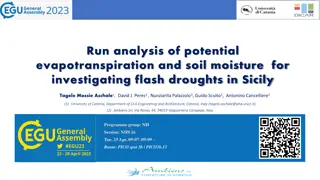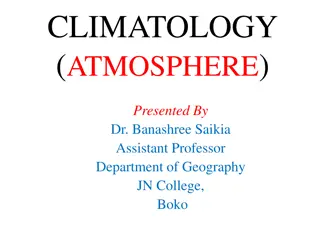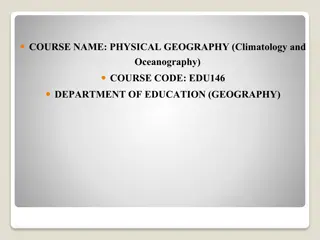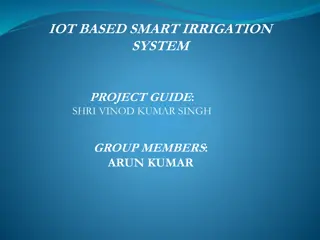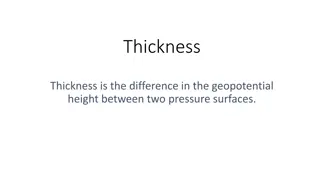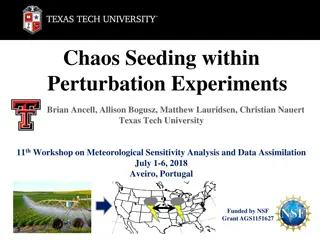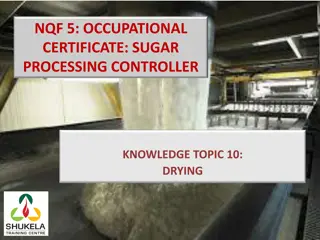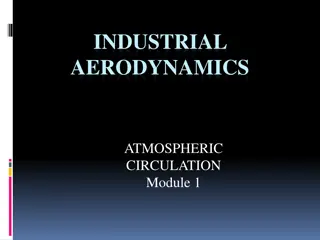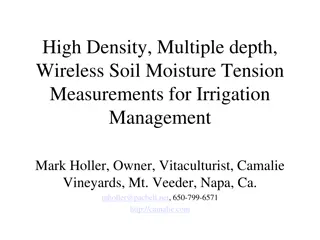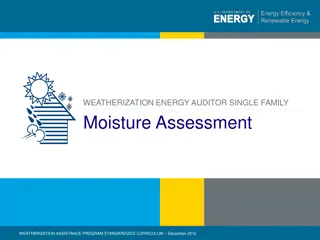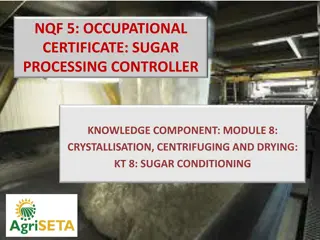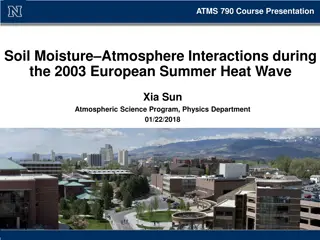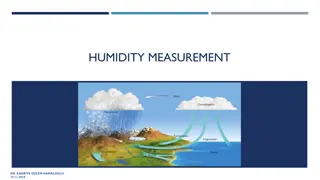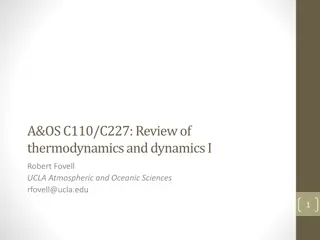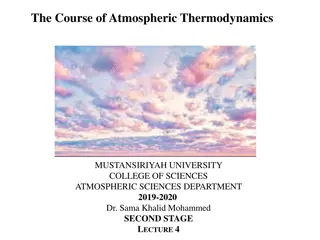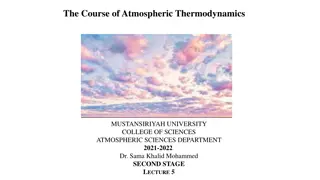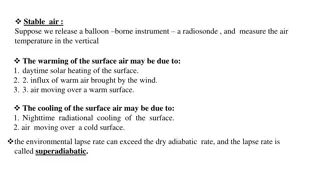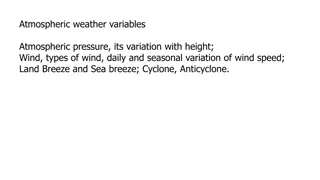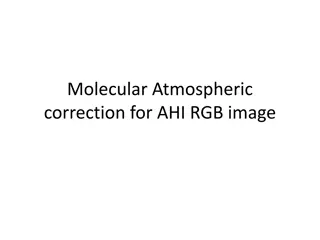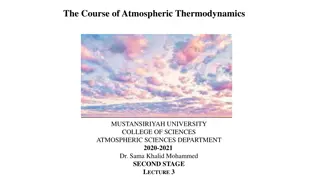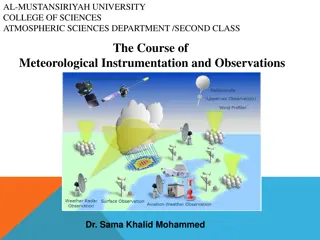Evaluation of SPLASH and HRRR Soil Moisture Comparison
This study compares soil moisture data between the HRRR model and SPLASH observations during the 2022 warm season. It explores differences in soil moisture levels at various depths, evaluates responses to precipitation events, and drydown periods. The research focuses on analyzed data from HRRR Mode
3 views • 12 slides
Investigating Flash Droughts in Sicily Using Evapotranspiration and Soil Moisture Analysis
This study focuses on identifying flash droughts in Sicily by analyzing potential evapotranspiration and soil moisture anomalies. The research examines trends in evapotranspiration and soil moisture levels over the past 22 years, pinpointing a possible flash drought occurrence in eastern Sicily in 2
3 views • 29 slides
Atmosphere Composition and Structure in Climatology
The study of climatology, focusing on the atmosphere, is presented by Dr. Banashree Saikia, covering topics such as atmospheric composition, insolation, temperature variations, atmospheric pressure, wind systems, atmospheric moisture, climatic classification, cyclones, and monsoons. The atmosphere,
2 views • 9 slides
Atmospheric Moisture in Physical Geography
Atmospheric moisture, in the form of water vapor, liquid water, and ice, plays a crucial role in shaping weather and climate. This course delves into the dynamics of atmospheric moisture, including its distribution, effects on weather patterns, and impact on various climatic factors such as precipit
0 views • 7 slides
IoT Based Smart Irrigation System Project Guide
Monsoon-dependent Indian agriculture can benefit from an automatic irrigation system that prevents both over- and under-irrigation. By leveraging wireless technology, such as sensors for soil moisture, air humidity, temperature, and water levels, this project aims to optimize crop production by savi
4 views • 14 slides
Atmospheric Thickness and Its Applications
Atmospheric thickness refers to the difference in geopotential height between two pressure surfaces, which is dependent on the mean virtual temperature of the layer in between. This concept plays a key role in determining temperature gradients, identifying fronts, and aiding in weather forecasting,
1 views • 11 slides
Atmospheric Pressure Variations at Different Altitudes
Atmospheric pressure varies with altitude due to the weight of the air column above. This activity explores how Otto von Guericke's experiments with vacuum systems demonstrate the power of air pressure. Theoretical concepts of atmospheric pressure are discussed, highlighting its relation to gravity
1 views • 28 slides
Cutting-Edge Atmospheric Chemistry Modeling Research at Barcelona Supercomputing Center
Conducted by the Atmospheric Composition Group at Barcelona Supercomputing Center, this cutting-edge research focuses on atmospheric chemistry modeling using advanced tools and frameworks like HERMESv3 and MONARCH. The team's approach integrates various modules to study complex processes influencing
0 views • 16 slides
Investigating Chaos Seeding in Perturbation Experiments
This research project conducted at Texas Tech University delves into the effects of chaos seeding within perturbation experiments on atmospheric conditions, with a focus on local and nonlocal modifications resulting from factors such as irrigation, wind farms, and urban development. By analyzing tin
0 views • 24 slides
Moisture Measurement in Sugar Processing
This content delves into the importance of moisture measurement in sugar processing, specifically focusing on the drying process. It explains how moisture percentage is crucial for various calculations and efficiency assessments in the sugar production industry. The equipment and procedures used for
0 views • 12 slides
Overview of Low-Cost Sensors for Atmospheric Composition Measurement
This publication provides an insightful overview of low-cost sensors for measuring atmospheric composition, covering topics like sensor technologies, applications in atmospheric sciences and air quality management, and evaluation methods. It emphasizes the importance of not only the technical perfor
0 views • 17 slides
Atmospheric Circulation on Earth
An atmospheric circulation driven by temperature differences between the equator and poles influences global weather patterns. The sun's changing angle throughout the year results in various pressure areas and the formation of large circulation cells. The main effects include the transport of humidi
1 views • 11 slides
Soil Moisture Retrieval Over Bare Surfaces Using Radar Observations
This study focuses on retrieving soil moisture over bare surfaces using radar observations and a lookup table representation of forward scattering. The research aims to develop a non-empirical and simple method for accurate soil moisture retrieval without the need for ancillary information. Issues w
0 views • 14 slides
Advances in Remote Sensing for Soil Moisture Validation and Calibration
Cutting-edge methods like Cosmic-Ray Neutron Sensing (CRNS) and mobile measurements are revolutionizing soil moisture validation and calibration. From satellite-based techniques to local approaches, researchers are enhancing the accuracy and reliability of soil moisture data for various applications
1 views • 15 slides
Wireless Soil Moisture Tension Measurements for Irrigation Management
High-density, multiple-depth wireless soil moisture tension measurements were conducted in a vineyard in Napa Valley. The study found correlations between soil moisture tensions and leaf water potential, offering valuable insights for irrigation management. Utilizing a wireless sensor network, the s
0 views • 16 slides
Moisture Assessment in Weatherization Energy Auditing for Single Family Homes
This December 2012 curriculum focuses on moisture assessment in the weatherization energy auditing process for single-family homes. It covers analyzing symptoms of moisture problems, identifying sources, understanding moisture control strategies, and using assessment tools. The training aims to equi
0 views • 26 slides
Climate Models and Moisture Equilibrium in Flexible Pavement Design
Climate inputs like temperature and moisture play key roles in flexible pavement design. The heat transfer model evaluates frost action and temperature regimes, while moisture equilibrium models consider the interaction between soil suction and moisture content. Understanding these factors is crucia
1 views • 13 slides
Sugar Processing Controller Knowledge: Conditioning and Moisture Control
Understanding the importance of sugar conditioning in preventing caking during transport and storage. Factors affecting sugar conditioning efficiency include temperature, air flow, crystal size, feed sugar moisture, and more. Learn about the techniques and processes involved in sugar conditioning to
0 views • 7 slides
Evaluation of Soil Moisture Estimates from Satellite-Based Products
The study evaluates soil moisture estimates from satellite-based products over two network regions. Soil moisture is crucial for the hydrological cycle, necessitating continuous monitoring due to its spatial and temporal variability. Remote sensing is utilized to gather information without physical
2 views • 5 slides
Soil Moisture-Atmosphere Interactions in the 2003 European Summer Heat Wave
This presentation discusses the significant impacts of soil moisture-atmosphere interactions during the 2003 European Summer Heat Wave, highlighting the abnormally hot weather, pavement buckling, and high-pressure systems that contributed to the extreme conditions. The images and diagrams illustrate
0 views • 27 slides
NSF Atmospheric Chemistry Program Overview
The NSF Atmospheric Chemistry Program aims to characterize the chemical composition of the atmosphere, understand chemical processes, quantify fluxes of chemical substances, study natural and anthropogenic causes of variability, and assess impacts on climate. The program supports research through pe
0 views • 6 slides
Atmospheric Chemistry Measurements and Methods
Explore the various types of atmospheric chemistry measurements, including research vs. monitoring, gas phase species, satellite vs. in situ observations, and spectroscopy and chromatography methods. Discover how researchers and regulatory bodies use different techniques to study and monitor air qua
1 views • 34 slides
Humidity: Measurement, Classification, and Calculation
Humidity is the amount of water vapor in the air, impacting weather conditions and human comfort. It can be classified as absolute humidity and relative humidity, each playing a crucial role in determining atmospheric moisture levels. The calculation of relative humidity involves comparing the vapor
0 views • 24 slides
Atmospheric Composition and Structure
The presentation covers fundamental concepts related to the Earth's atmosphere, including its composition, origin of oxygen, dry and moist layers, standard atmosphere layers, and temperature variations. Key topics discussed include the primordial atmosphere, atmospheric constituents, water vapor dis
0 views • 58 slides
Atmospheric Thermodynamics and Humidity Measurements
Explore the key concepts of atmospheric thermodynamics including wet bulb temperature, wet bulb depression, dew-point temperature, and relative humidity. Learn how meteorologists use psychrometric charts to measure humidity and analyze air moisture content. Discover the significance of wet bulb depr
1 views • 20 slides
Moisture in the Atmosphere and Its Impact on Weather
Explore the dynamics of moisture in the atmosphere, including concepts like mass mixing ratio, volume mixing ratio, dew point, wet bulb temperature, and saturated vapor pressure. Learn about the Clausius-Clapeyron equation, supercooled water phenomena, and the effects of latent heating on atmospheri
1 views • 10 slides
Atmospheric Thermodynamics and Environmental Lapse Rate
Explore the concepts of atmospheric thermodynamics including the Parcel Method, Environmental Lapse Rate, and Conditionally Unstable Atmosphere. Dive into the details of how air parcels behave in different atmospheric conditions and understand the significance of temperature changes in the atmospher
0 views • 27 slides
GEOS-Chem Atmospheric Chemistry Model Overview
GEOS-Chem, developed by Daniel J. Jacob at Harvard University, is a global model of atmospheric composition used to understand human and natural influences on the environment. The model addresses various atmospheric chemistry issues on different scales, from local to global, and is regularly updated
1 views • 19 slides
Atmospheric Stability and Adiabatic Processes
Atmospheric stability is crucial in determining weather conditions. Different processes such as adiabatic cooling play a significant role in the vertical movement of air masses. Understanding the environmental lapse rate, moist and dry adiabatic rates, and the concept of conditional instability help
0 views • 4 slides
Atmospheric Pressure, Wind Variations, and Humidity in Weather Systems
The atmosphere is composed of various elements like gaseous molecules, water vapor, and dust particles. Key weather variables include atmospheric pressure, temperature, humidity, wind, cloud cover, and precipitation. Atmospheric pressure is influenced by the weight of air above a point, with average
1 views • 17 slides
The DC and AC global atmospheric electric circuits as central tenets in Earth system science today
The presentation at the EGU General Assembly highlighted the significance of DC and AC global atmospheric electric circuits in Earth system science. Key references from 2007 to 2018 underscore the evolving research in this field, exploring the interconnectedness between the space environment and the
0 views • 23 slides
Addressing the Gap Between Graduates' Skills and Employers' Expectations in Atmospheric Geosciences
The article discusses the skills gap in the atmospheric geosciences field, highlighting key technical and communication skills needed by graduates and postgrads. It explores strategies to bridge this gap through surveys, creative solutions, and innovative approaches like updating degree requirements
0 views • 5 slides
Analysis of Atmospheric Parameters and Transmission at OHP in 2018
This analysis focuses on the atmospheric parameters and transmission at the Observatoire de Haute-Provence (OHP) during 2018, with a specific emphasis on distinguishing between typical winter and summer conditions. The study utilizes MERRA2 data from January to August to examine pressure, precipitab
0 views • 16 slides
Atmospheric Correction Techniques for Satellite Image Enhancement
Atmospheric correction is essential for improving the quality of Remote Sensing images captured by satellites. This process involves correcting for the effects of atmospheric gases such as scattering and absorption on the measured Top-of-Atmosphere (TOA) reflectance. Techniques like molecular correc
0 views • 8 slides
Future Changes in Atmospheric Rivers in Norway
Research investigates future trends in atmospheric rivers and extreme precipitation in Norway. Findings show increasing frequency and intensity of atmospheric rivers in the Far-Future, particularly during summer, with winter precipitation rising on the mid- and south-west coasts. Utilizing data obse
0 views • 13 slides
Atmospheric Sciences 101 Atmospheric Sciences 101
Dive into the fascinating world of atmospheric sciences with this comprehensive course. Learn to interpret weather maps, satellite imagery, and radar data. Explore key atmospheric phenomena and their relation to physical principles and laws. Discover how to be a savvy weather consumer by understandi
0 views • 10 slides
Understanding Atmospheric Moisture in Physical Geography
Explore the significance of atmospheric moisture in controlling weather and climate conditions, including the role of water vapor, liquid water, and ice. Learn about evaporation, precipitation patterns, and the impact of water content on various atmospheric phenomena.
1 views • 7 slides
Understanding Atmospheric Sciences Course: Winter 2023
Gain an understanding of synoptic systems, dynamical concepts, and weather forecasting in the Atmospheric Sciences 370 course for Winter 2023 with Cliff Mass and Rick Steed. Explore the structure and evolution of weather phenomena, developing essential skills in atmospheric analysis and forecasting
0 views • 6 slides
Atmospheric Thermodynamics Lecture: Virtual Temperature and Wet Bulb Concepts
Explore the key concepts of virtual temperature and wet bulb temperature in atmospheric thermodynamics. Learn about the virtual temperature as a measure of moisture content in moist air and the significance of wet bulb temperature in humidity measurement. Dive into the relationships between these pa
0 views • 19 slides
Meteorological Instrumentation and Observations Course Overview
Explore the comprehensive curriculum of the Meteorological Instrumentation and Observations course at Al-Mustansiriyah University College of Sciences At the Atmospheric Sciences Department. Covering data processing, temperature measurement, wind measurement, radiation, pressure measurement, moisture
0 views • 35 slides

